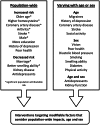Risk factors for late-life cognitive decline and variation with age and sex in the Sydney Memory and Ageing Study
- PMID: 23799051
- PMCID: PMC3683032
- DOI: 10.1371/journal.pone.0065841
Risk factors for late-life cognitive decline and variation with age and sex in the Sydney Memory and Ageing Study
Abstract
Introduction: An aging population brings increasing burdens and costs to individuals and society arising from late-life cognitive decline, the causes of which are unclear. We aimed to identify factors predicting late-life cognitive decline.
Methods: Participants were 889 community-dwelling 70-90-year-olds from the Sydney Memory and Ageing Study with comprehensive neuropsychological assessments at baseline and a 2-year follow-up and initially without dementia. Cognitive decline was considered as incident mild cognitive impairment (MCI) or dementia, as well as decreases in attention/processing speed, executive function, memory, and global cognition. Associations with baseline demographic, lifestyle, health and medical factors were determined.
Results: All cognitive measures showed decline and 14% of participants developed incident MCI or dementia. Across all participants, risk factors for decline included older age and poorer smelling ability most prominently, but also more education, history of depression, being male, higher homocysteine, coronary artery disease, arthritis, low health status, and stroke. Protective factors included marriage, kidney disease, and antidepressant use. For some of these factors the association varied with age or differed between men and women. Additional risk and protective factors that were strictly age- and/or sex-dependent were also identified. We found salient population attributable risks (8.7-49.5%) for older age, being male or unmarried, poor smelling ability, coronary artery disease, arthritis, stroke, and high homocysteine.
Discussion: Preventing or treating conditions typically associated with aging might reduce population-wide late-life cognitive decline. Interventions tailored to particular age and sex groups may offer further benefits.
Conflict of interest statement
Figures
References
-
- Millan-Calenti JC, Tubio J, Pita-Fernandez S, Rochette S, Lorenzo T, et al. (2012) Cognitive impairment as predictor of functional dependence in an elderly sample. Arch Gerontol Geriatr 54: 197–201. - PubMed
-
- Plassman BL, Williams JW Jr, Burke JR, Holsinger T, Benjamin S (2010) Systematic review: factors associated with risk for and possible prevention of cognitive decline in later life. Ann Intern Med 153: 182–193. - PubMed
-
- Arntzen KA, Schirmer H, Wilsgaard T, Mathiesen EB (2011) Impact of cardiovascular risk factors on cognitive function: The Tromso study. Eur J Neurol 18: 737–743. - PubMed
-
- Artero S, Ancelin ML, Portet F, Dupuy A, Berr C, et al. (2008) Risk profiles for mild cognitive impairment and progression to dementia are gender specific. J Neurol Neurosurg Psychiatry 79: 979–984. - PubMed
Publication types
MeSH terms
LinkOut - more resources
Full Text Sources
Other Literature Sources
Medical


